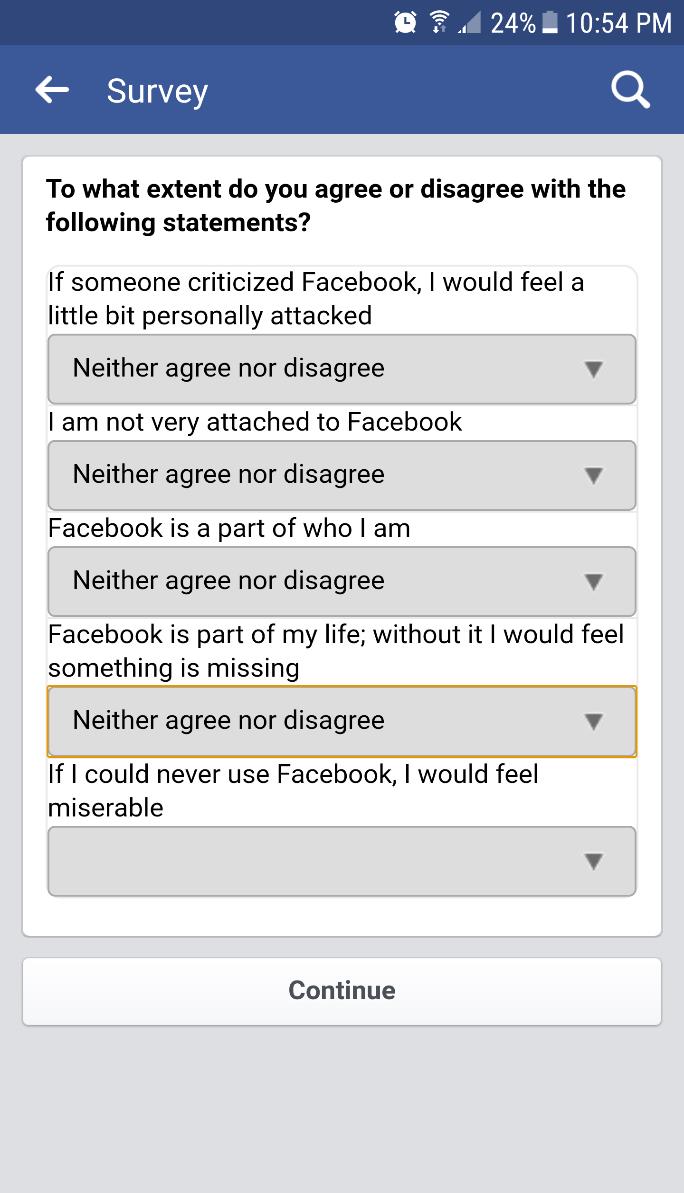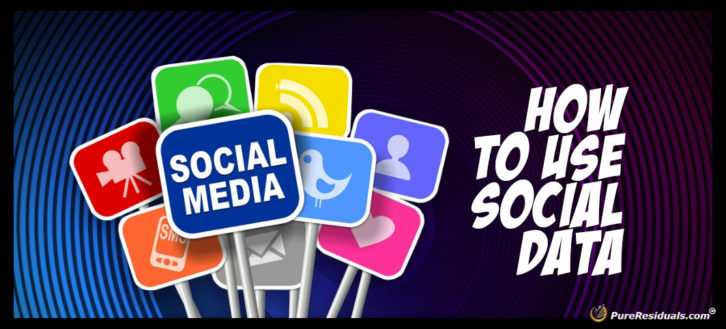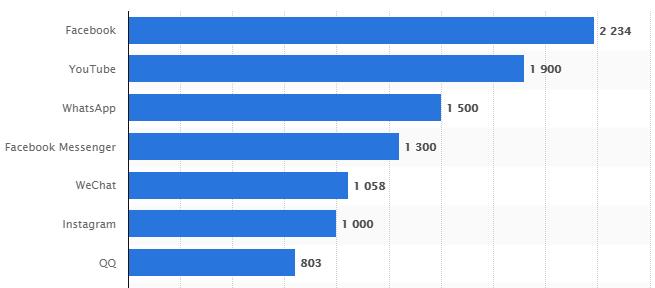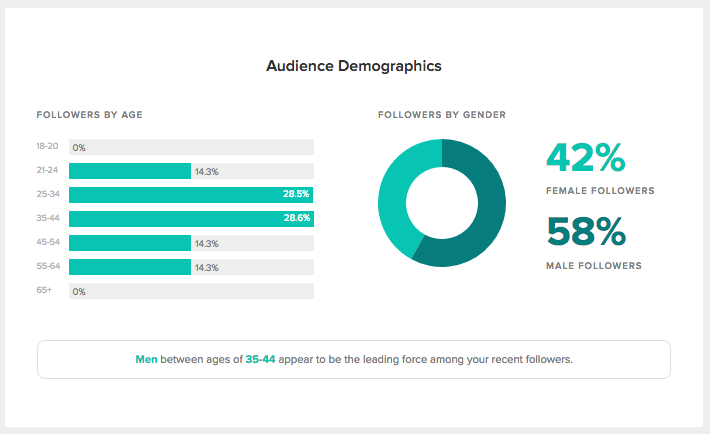For a business, the more exposure you get, the more brand awareness you create, the faster you’ll be able to reach success. There are many traditional ways to let people around the world learn about your business and your product, but lately, they’ve proven to be quite ineffective and too expensive.
Why?
Because of social media.
The emergence of social media platforms has brought new tools for the brands. Marketing on social media has proven to be a highly effective and a rather inexpensive way to promote your business, comparing to more traditional marketing strategies.
Besides, using social media platforms to promote your brand is probably the only way to reach massive audiences. It has been reported that in 2018 2.62 billion people worldwide already had at least one social media account, and the numbers are expected to reach 3 billion by 2021.
Speaking about each particular social media platform and the number of users they engage, statistics show the following:
So, as you can see, using social media platforms for marketing purposes bring a lot of opportunities to get out there and introduce your brand to massive audiences.
But, what’s even more important is that social media also provide brands with massive amounts of social data, crucial for a successful marketing campaign.
What is Social Data and How to Mine It?
Essentially, social data represents the information that is publicly shared by social media users and includes metadata like location, language, means of communication, personal data, and shared links. Basically, social data is analytics, metrics, and statistics describing how users engage with your content.
Mining social data is the process that involves:
- real-time analysis of social media platforms;
- analysis of influence, reach and relevance of social media platforms to be used in marketing campaigns;
- viral activity on social media;
- studying raw social data to later apply it during the development of the marketing plan.
Social data can be collected automatically from social media business accounts, as social media platforms provide users with certain analytics tools. There are other similar comprehensive online tools like Google Analytics that allow businesses to perform social data analysis across all social media accounts at once and also provide real-time updates.
Now that we have studied a bit, what social data is, let’s take a look at how business owners and entrepreneurs can use it to launch a successful marketing campaign.
Incorporate Social Data to Define Audience Personas
Knowing your target audience means that you’re already halfway to a successful marketing campaign. As a business owner, you know who your target audience is and who you want to be interested in buying your product.
But when it comes to marketing campaigns, audience personas may differ each time you launch a new campaign. That’s where you can resort to social data to define audience personas for your next marketing campaign.
Information on audience personas includes:
- background (occupation, education, hobbies);
- demographics (gender, age, income, preferable location);
- buzzwords that will trigger the attention of your target audience.
All this information can be collected from social media, where you can actually see, where your following is the most active, where they are located, and within which age range your followers are the most engaged.
To define the target audience for your next marketing campaign, you can also survey your followers to get the full scope of social data from their feedback. “Social media platforms provide enough tools for surveying your following base”, says Kate Jefferson, a marketing specialist at Flatfy. “You can do it in a fun way on Instagram or in a more sophisticated, old-fashioned way on Facebook.”
 |  |
You can also obtain social data from your followers by inviting them to participate in regular surveys, which can be done with the help of:
Doing surveys will give you the necessary feedback, from which you can get enough social data to identify the audience personas for your next marketing campaign.
Use Social Data to Find the Right Platform
Using all existing social media platforms for one marketing campaign isn’t the best idea. You need to understand that each social media platform has a particular type of content that works best for its users. For instance,
- regular blog posts work best for Facebook;
- short videos and images are great for Twitter;
- live streams, IGTV videos, and carousel photos work best for Instagram, and
- stories are great for Snapchat.
When planning a marketing campaign, you need to analyze, how well your content is doing on each of the social media platforms and see, which one you’d prefer to use as the main marketing platform. Social data, collected from likes, shares, and follower feedback will give you enough information on how your followers perceive your content.
It is also important to keep in mind the gender use of social media. Social media platforms do not have an even distribution of followers when it comes to age and gender. Pew Research reports the following:
If you have already defined your target audience, make sure your audience personas correspond to the gender use of the preferred social media platform. This way you’ll be able to maximize the effectiveness of your marketing campaign and reach your goals.
Engage Social Data to Study Social Media Trends
Before you launch your marketing campaign, you need to know what’s trending. Getting real-time social data can give you enough information on what trends dominate on social media and many examples of how you can incorporate some of them into your marketing campaign.
One of the ways to learn about social media trends is performing hashtag analysis. A hashtag is a kind of a guide around a certain social media platform that helps the users find content that corresponds to this hashtag.
Doing a hashtag analysis means that you take a hashtag and you study its popularity, weekly and monthly performance. Here’s how the hashtag analysis of #love, done on Hashtagify.me, looks like:
Performing hashtag analysis can also give you the full scope of social data on the top language variations this hashtag is used, spelling variants, and the countries where this hashtag is the most popular. You can also get this information from the list of trending hashtags, which is regularly updated.
All this data is necessary for you to know how to incorporate hashtags into your marketing campaign and how to use them to keep track of social media trends.
Use Social Data to Improve Customer Support Service
When you launch your marketing campaign, you need your customer support service spotless and working like a clock. Not only because customer support if the face of your business, but because they also collect valuable social data to help you make sure that you’ll be able to reach the goals of your marketing campaign.
Customer support service helps keep track of the following important aspects:
- the volume of requirements;
- response time and rates;
- resolution times and rates.
Today, customer support service is also required to be active on social media. Reportedly, 67% of consumers use social media for the sole purpose of contacting brands. If your customer support is already using social media to communicate with customers, you can take it to another level by obtaining social data to create user guides, automate communications and create a customer portal.
Get your customer support to analyze inquiries from your customers when the marketing campaign is already launched. The feedback from your customers provides you with valuable social data that can help you make necessary changes to the campaign in order to achieve the goals.
In general, having your customer support service analyze social data which comes from customer inquiries on a regular basis is a must. After all, if you want your target audience to be satisfied, you need to take their opinion into account.
Use Social Data to Track Your KPIs
Lastly, let’s talk about the importance of social data to help you achieve the KPIs of your marketing campaign. KPIs (key performance indicators) must be regularly analyzed to help you understand whether you’re moving towards your goals or not.
KPIs should correspond to your marketing strategy and should represent the goals that you want to achieve. Social data can help you understand better, how your content is performing, how your followers perceive it and what needs to be changed in order to bring benefit both for you and for your target audience.
Tracking your KPIs is a regular task. As you launch your marketing campaign, you’ll have real-time social data to help you see how your campaign is performing. You’ll get raw social data that can later be transformed into a powerful tool to help you understand what’s working and what’s not, so you should definitely take advantage of it.
Use Social Data to its Full Potential
Social data can bring business owners and entrepreneurs a lot of benefits when it comes to launching a marketing campaign. You can use it on each step of developing your campaign, from figuring out your target audience and identifying the perfect platform to tracking your KPIs in order to reach the ultimate goal. Hopefully, this guide will help you understand how social data works, so you could use it to bring your next marketing campaign to success.
About the Author














Social Media Marketing Trends are essential for digital marketing. You can’t achieve success in social media marketing until you follow the latest trends for brand awareness.
Toady’s Affiliated marketing trend that product owner to connect the right users.
Social media marketers must refer to this piece of content. It is really worth giving time to read this. I myself follow your contents a lot as they are very informative. Keep writing.
Now where ever you are around the world if you want to tell about your business or giving new information on social media is the best way to tell about your self social media is the platform where you can promote your brand